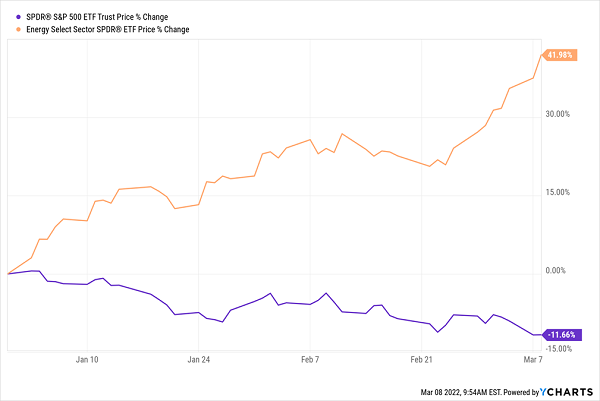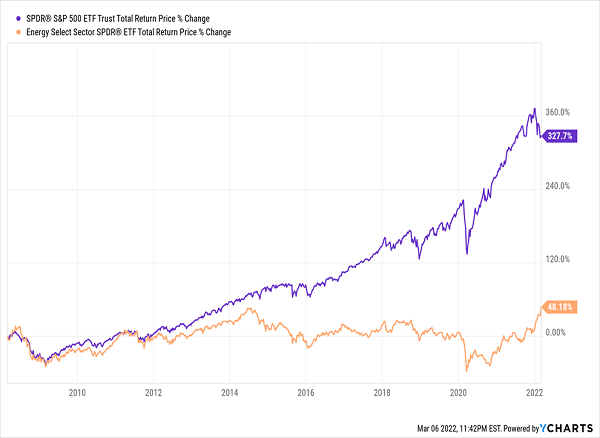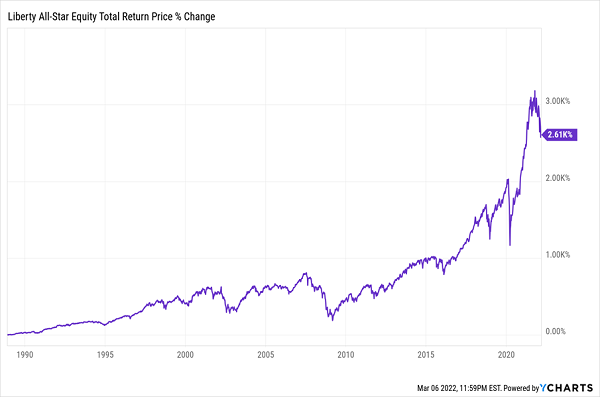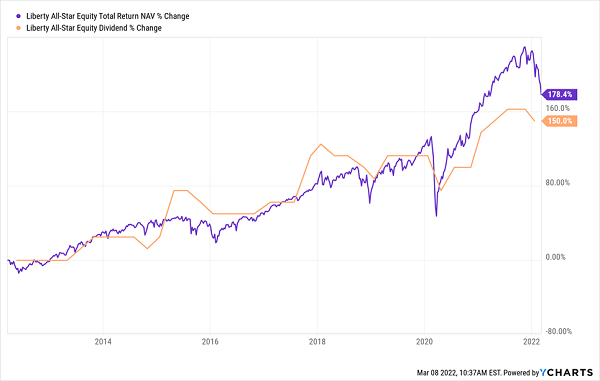Ignore the overtorqued headlines about inflation: even though prices are rising, they won’t take out the economy.
In fact, rising inflation is setting us up with a contrarian opportunity to grab double-digit dividends in a corner of the market everyone’s written off. That would be consumer-discretionary stocks, which you’d think would be the main victims of inflation, but that’s far from the case, for reasons we’ll get into shortly.
We’ll also delve into one smartly run consumer-focused closed-end fund (CEF) yielding an outsized 11% below. But first we have to talk strategy, because while there are opportunities for us, this twitchy market also includes some traps we need to watch for.
One involves oil, whose surge is nicely captured by the oil stock–heavy Energy Select Sector SPDR ETF (XLE), in orange below.
Oil’s the Only Sector in the Green These Days

Sure, soaring oil prices are great for the likes of ExxonMobil (XOM), Chevron (CVX) and EOG Resources (EOG), and oil’s run could very well continue for a long time. But we do need to be aware of history here.
For example, if you bought energy stocks the last time oil spiked this high, you would’ve gotten in just as a downturn hit and energy took a backseat to the rest of the market.
History Tells Us to Be Careful With Oil

Of course, we needn’t drop oil completely; we just need to take a diversified approach, while keeping oil as a reasonable portion of our portfolio.
That leaves plenty of room for other sectors, including consumer-discretionary stocks, peddlers of everything from electronics to housewares. (And of course, dividend investors we are, we want that exposure through high-yield CEFs that hold these companies.)
I know that buying consumer-discretionary stocks sounds counterintuitive, with prices for gasoline and other essentials soaring, drawing money away from small pleasures, like shopping. But here too, we need to pay attention to history.
Gas Prices Are Still Below Historic Highs

Source: AAA
Sure, current average prices of $4.173 per gallon in the US are at all-time highs, just above the record of $4.10 we saw in July 2008. But bear in mind also that median household income is up 34% since then.
What’s more, this spike in gas prices could be short-lived as US shale producers increase output and a potential new Iran nuclear deal brings that country’s production back online.
So yes, consumers will be spending less than they would be in a universe where Vladimir Putin didn’t invade Ukraine. But they still have a lot more discretionary income than they did in 2008—and they still will, even if oil goes higher.
Our “Double Discounted” Chance to Buy an 11% Dividend (That Grows)
Even with this in mind, panic selling has set up some bargain opportunities on these stocks. That’s one reason why I’m particularly bullish on a US-based equity fund like the Liberty All-Star Equity Fund (USA), which, as the name and ticker suggest, focuses on American companies; USA also has strong exposure to consumer goods.
A History of Big Profits (and Dividends)

USA’s current holdings of Amazon.com (AMZN), Alphabet (GOOG), UnitedHealth Group (UNH), Microsoft (MSFT) and Visa (V) leave it well-positioned to benefit from a rebound among oversold consumer discretionary firms that have been dumped by investors panicking over oil.
When investors realize that, in reality, the situation in Ukraine isn’t all that bad for American companies (and, with Europe pivoting toward the US, might actually help them in the long term), they’ll want to pick up these stocks.
That’s just one way that USA is in a good position to rise. Here’s another: six months ago, the fund was trading at a 15% premium to net asset value (NAV, or the value of the stocks in its portfolio). Today it trades just above par: a 2% premium as I write this. Obviously, a return to a premium that high (inevitable, in my view) would slingshot the share price higher.
Then there’s the blockbuster yield: USA pays an 11.1% dividend, and that payout has grown an astonishing 150% over the last decade as management has handed the bulk of the fund’s profits to investors as dividends.
USA’s 11% Dividend Rises With Its NAV

As you can see above, the fund’s dividend tracks its net asset value (NAV) closely, and its NAV has returned 13.25% annualized over the last decade, easily covering its dividend.
I expect that run (in both NAV and dividend growth) to keep going as USA smartly picks up bargains in the current panic. The fact that we can get in without paying a high premium adds extra appeal.
Urgent: 5 “Must-Buy” CEFs for 7.4% Dividends, Upside in All Market Weather
USA is a great fund, but the one snag is that it’s still trading at a modest premium, so we’re better to hold off on it and go after 5 other CEFs I’m urging ALL investors to buy right away.
Taken together, these 5 funds yield a healthy 7.4%, and they give you instant diversification (a must in volatile markets like these), with exposure to the top healthcare stocks, sturdy US blue chips, top-quality corporate bonds and the best tech stocks to profit from the boom in artificial intelligence.
The best part? These 5 funds trade at such a deep discount that each has the potential to post 20%+ price gains in the year ahead!
Don’t miss your chance to buy these 5 tightly run income plays while they’re cheap. Click here and I’ll give you everything you need to know about each of them: names, tickers, current yields, discounts, best-buy prices and more.
